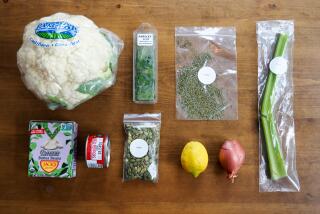Keep Kitchen Clean : How to Lessen Your Chances of Food Poisoning at Home
- Share via
As part of an effort to improve food-handling practices, federal officials have issued guidelines for reducing the number of home food-poisoning cases.
Douglas L. Archer, microbiology director for the FDA’s Center for Food Safety and Applied Nutrition, reviewed several ways of minimizing risks at a recent conference.
Primary among these is the need to eliminate cross-contamination, a situation where raw meats come in contact with cooked or ready-to-eat foods. This transfer of bacteria from potentially contaminated foods to wholesome ones can happen on cutting boards, utensils or in a food storage area such as a refrigerator.
Cooked and Raw Foods
One example of cross-contamination is the supermarket practice of stocking cooked shrimp alongside raw fish in seafood counters. The proximity of a cooked food to a raw item facilitates potentially dangerous bacterial transmission, Archer said.
Cross-contamination can also occur from hands and the FDA has frequently recommended that cooks wash with soap and hot water between preparation of each ingredient, particularly meats and seafood.
Archer also emphasized that foods need to be cooked at the proper temperature. Eggs heated until the whites harden, he said, would be sufficient to destroy any salmonella. Thorough heating will also destroy pathogens such as Listeria monocytogenes, Escherichia coli, Clostridium botulinum and Vibrio vulnificus in other foods.
“Eating raw meats and shellfish is not good and never has been,” said Catherine E. Adams of the USDA’s Food Safety and Inspection Service. “And we need to convince people to not eat raw products.”
Temperature variations are also an area that causes problems, said Archer. Oftentimes foods are left out too long before being refrigerated. Safety requires that cold foods should be kept below 40 degrees Fahrenheit and hot foods heated to at least 165 degrees.
Storage practices are another potential hazard such as when large amounts of prepared food are placed in a single container and then refrigerated or frozen. Frequently, bacteria will quickly multiply in the center of any such containers before the foods have properly cooled.
Archer recommends that cooked foods be divided into several smaller packages before being stored in the refrigerator. A similar principle applies for thawing: Frozen foods are not to be thawed over extended periods at room temperature. Instead, the items should be placed in the refrigerator, submerged under cold, running water or in a microwave oven.
Pets can also be a potential source of bacteria. They should be kept from food handling areas of the kitchen and not allowed to come in contact with food for human consumption.
Food is not the only place where bacteria may thrive.
Archer also says the pathogens can be found in sponges, dish towels, used paper towels, aprons, cutting boards, sinks, counter tops, wooden utensils and at the base of blender jars. Each of these should be cleansed thoroughly between usage or food preparation.
“Bacteria have been around longer than people. And if you give them enough time at the right temperature then bacteria will grow,” he said.
Using a somewhat familiar theme to prevent carelessness in the home, Archer added that it is “people who cause illnesses, not germs.”
More to Read
Eat your way across L.A.
Get our weekly Tasting Notes newsletter for reviews, news and more.
You may occasionally receive promotional content from the Los Angeles Times.









